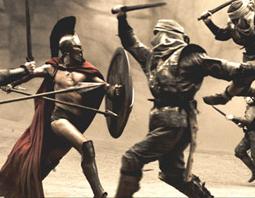 Just once, I would like to be able to watch a movie and not have to worry about whether I should feel guilty about enjoying it. “300“–a stylized sword-and-sandal take on the epic Battle of Thermopylae, based on Frank Miller’s graphic novel of the same name–seemed like a good opportunity. Alas, this was not the case.
Just once, I would like to be able to watch a movie and not have to worry about whether I should feel guilty about enjoying it. “300“–a stylized sword-and-sandal take on the epic Battle of Thermopylae, based on Frank Miller’s graphic novel of the same name–seemed like a good opportunity. Alas, this was not the case.
Although happily received by audiences to the tune of $70 million this past weekend, critics have attacked the film, condemning its violence and what they see as a subtext of racism and misogyny. One review went so far as to say, “In the wrong hands, ‘300’ could be a lethal weapon,” thanks to the current West vs. East political atmosphere. The Middle East Times reports that Iranian “press, officials, and bloggers have united in denouncing the film as another example of ‘psychological warfare’ against Tehran by its American archenemy at a time of mounting tension over its nuclear program.”
“300” is the story of the Spartan king Leonidas, who, against the advice of the oracles and Spartan law, decides that he and a group of 300 of his best men will defend Sparta from an invasion of the Persian army commanded by the self-proclaimed man-god Xerxes. This Spartan has brains as well as brawn, arguing that the men accompanying him aren’t an army, per se, but a detachment of his personal body guards. (Gotta love them Laconic loopholes!) Besides, Leonidas has faith in his men, not in the bought-and-paid-for utterings of the oracles.
Miller’s main inspiration was the 1962 film “The 300 Spartans,” which itself was, according to Wikipedia, “noted for its Cold War overtones.” Needless to say, it is not an ultra-faithful rendering of historical fact. Then again, the very world of the story isn’t rendered in a way that is faithful to reality–similar to the way that Miller’s “Sin City” was colored for the big screen, manipulated to darken every angle, every crease with a sepia wash.
But unlike “Sin City,” the violence here is neither gratuitous nor sadistic and is a fairly realistic depiction of battle–as realistic as a film attempting to recreate the feel of a comic book can be. The sequences often are absolute ballet. In fact, recent episodes of HBO’s “Rome” have been far more graphic, depicting more violence and misogyny.
If anything, the film might be guilty of mild Orientalism. But, the same could be said for “Stargate” and numerous other films that dress the often-androgynous enemy “other” in vaguely Eastern attire. Sure, the non-white faces of the Persian army could be seen as racist when set against the noble white perfection of the Spartans, but it may also be an attempt to illustrate the extent of an empire that could draw forces from possessions all over what is now the Middle East, the Arabian peninsula and North Africa. And while Miller has made some belligerent comments about the Muslim world post-9/11, the graphic novel of “300” was published in 1999.
On a more practical level, the pace of the film has been criticized as too slow (though I found it an interesting change from typical action flicks), and some say the actors are chewing the scenery; that is, if there was actual scenery to chew. (The entire film was shot using blue screen technology.) The real flaw for me came at the end of the film, when Dilios, having finished telling the tale of Leonidas, spurs on the full Spartan army at the final Battle of Plataea by saying that they will crush “mysticism and tyranny” by beating the Persians.
Certainly, throughout the film we get glimpses of Leonidas’ perfunctory treatment of state religion and his contempt for the “god-king” pretentions of Xerxes; Leonidas is out to prove to the Persians that they are commanded by a mere mortal who bleeds. Across the battlefield, Xerxes paints himself as a merciful god who welcomes the deformed and the debauched, in contrast to the Spartans, who dispose of weak or “defective” infants. But the overwhelming sense of purpose for the Spartans seems to be the defense of their homeland’s autonomy, rather than defense of their religion. Then again, this is a direct shot-for-shot recreation of a comic book, not a theological treatise.
It may be easiest to describe “300” as the swords, sandals, and chiseled chests of “Gladiator” meets the special effects of the “Lord of the Rings” meets the crusade rhetoric of “Kingdom of Heaven” meets the rag-tag freedom fighters of “Star Wars” meets the go-down-fighting nobility of “The Alamo.” And throw in just a little bit of “Stargate” for our man-god Xerxes. Sure, it’s a bit derivative, but the beauty of the film is in it’s very Spartan nature–a simple, familiar storyline, just enough character development and fantastic action scenes.


